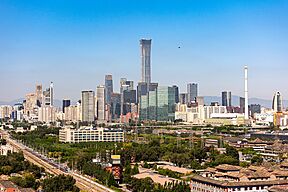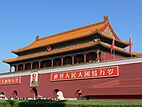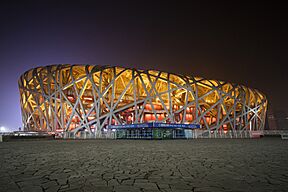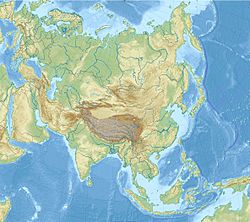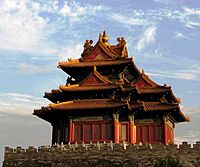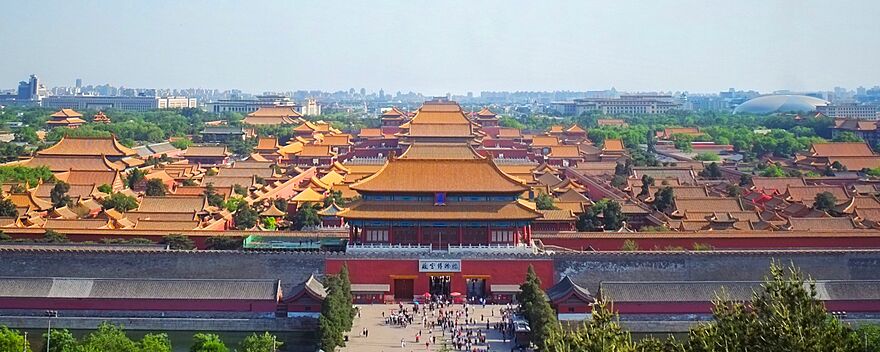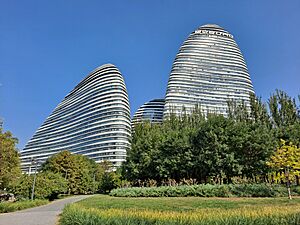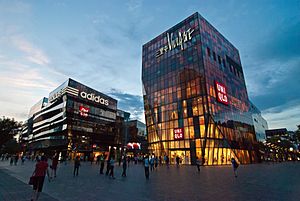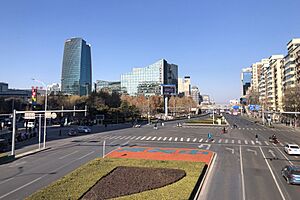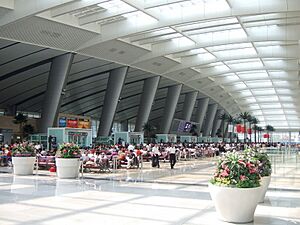Beijing facts for kids
Quick facts for kids
Beijing
北京
Peking
|
|||||||||||
|---|---|---|---|---|---|---|---|---|---|---|---|
|
Capital and municipality
|
|||||||||||
| Beijing Municipality | |||||||||||
|
Beijing central business district with the China Zun (center)
Great Wall of Badaling
Beijing National Stadium "Bird's Nest"
|
|||||||||||

Location of Beijing Municipality within China
|
|||||||||||
| Country | |||||||||||
| Established | 1045 BC | ||||||||||
| Founded by | Zhou dynasty (Western Zhou) | ||||||||||
| Municipal seat | Tongzhou District | ||||||||||
| Divisions - County-level - Township- level |
16 districts 343 towns and subdistricts |
||||||||||
| Government | |||||||||||
| • Type | Municipality | ||||||||||
| • Body | Beijing Municipal People's Congress | ||||||||||
| Area | |||||||||||
| • Municipality | 16,410.54 km2 (6,336.14 sq mi) | ||||||||||
| • Land | 16,410.54 km2 (6,336.14 sq mi) | ||||||||||
| • Urban | 16,410.54 km2 (6,336.14 sq mi) | ||||||||||
| • Metro | 12,796.5 km2 (4,940.8 sq mi) | ||||||||||
| Elevation | 43.5 m (142.7 ft) | ||||||||||
| Highest elevation
(Mount Ling)
|
2,303 m (7,556 ft) | ||||||||||
| Population
(2020 census)
|
|||||||||||
| • Municipality | 21,893,095 | ||||||||||
| • Density | 1,334.0874/km2 (3,455.2706/sq mi) | ||||||||||
| • Urban | 21,893,095 | ||||||||||
| • Urban density | 1,334.0874/km2 (3,455.2706/sq mi) | ||||||||||
| • Metro | 22,366,547 | ||||||||||
| • Metro density | 1,747.864/km2 (4,526.948/sq mi) | ||||||||||
| • Population ranking | 2nd in China 2nd in Asia 27th as an administrative division Density: 4th |
||||||||||
| Major ethnic groups | |||||||||||
| • Han | 95% | ||||||||||
| GDP | |||||||||||
| • Municipality | CN¥ 4,984 billion (13th) US$ 700 billion |
||||||||||
| • Per capita | CN¥ 227,652 (1st) US$ 32,038 |
||||||||||
| Time zone | UTC+08:00 (CST) | ||||||||||
| Postal codes |
100000–102629
|
||||||||||
| Area code(s) | 10 | ||||||||||
| ISO 3166 code | CN-BJ | ||||||||||
| Growth | |||||||||||
| License plate prefixes | 京A, C, E, F, G, H, J, K, L, M, N, P, Q 京B (taxis) 京G, Y (outside urban area) 京O, D (police and authorities) |
||||||||||
| Abbreviation |
|
||||||||||
| HDI (2023) | 0.912 (1st) – very high | ||||||||||
| Website | |||||||||||
|
|||||||||||
| Beijing | |||||||||||||||||||||||||||||||||||||||
|---|---|---|---|---|---|---|---|---|---|---|---|---|---|---|---|---|---|---|---|---|---|---|---|---|---|---|---|---|---|---|---|---|---|---|---|---|---|---|---|

"Beijing" in regular Chinese characters
|
|||||||||||||||||||||||||||||||||||||||
| Chinese | 北京 | ||||||||||||||||||||||||||||||||||||||
| Hanyu Pinyin | Běijīng | ||||||||||||||||||||||||||||||||||||||
| Postal | Peking Peiping (1368–1403; 1928–1937; 1945–1949) |
||||||||||||||||||||||||||||||||||||||
| Literal meaning | "Northern Capital" | ||||||||||||||||||||||||||||||||||||||
|
|||||||||||||||||||||||||||||||||||||||
Beijing (pronounced bay-JING) is the capital city of China. It is one of the biggest cities in the world, with over 21 million people living there. For centuries, it has been a center for culture, politics, science, and education in China. An older English name for the city is Peking.
Beijing is a mix of old and new. It has amazing historical sites like the Forbidden City, the Temple of Heaven, and parts of the Great Wall of China. It also has modern skyscrapers and is a major hub for business and travel. The city's subway system is one of the longest and busiest in the world.
The city is famous for hosting the 2008 Summer Olympics. In 2022, it became the first city ever to host both the Summer and Winter Olympics. Beijing is a global city, meaning it is an important center for the world's economy and culture.
Contents
What Does "Beijing" Mean?
The name Beijing (北京) means "Northern Capital" in Chinese. The city was given this name in 1403 during the Ming dynasty. This was to show it was different from Nanjing, which means "Southern Capital."
The older spelling, Peking, came from early European visitors. Today, some places like Peking University and the city's main airport code (PEK) still use this old name. The official abbreviation for Beijing is "BJ".
History of Beijing
Early History
People have lived in the Beijing area for a very long time. Fossils of an early human called Peking Man, who lived around 250,000 years ago, were found in caves near the city.
The first walled city in the area was called Jicheng. It was built over 3,000 years ago, in 1045 BC. For hundreds of years, different kingdoms and dynasties controlled the city. During the Sui dynasty, it became the northern end of the famous Grand Canal, a man-made river used for shipping goods.
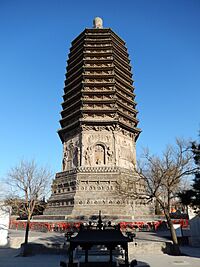
A New Capital City
In the 1200s, Kublai Khan, the grandson of Genghis Khan, built a grand new capital for his Yuan dynasty. He called it Dadu. This city was built near the ruins of older cities and became the foundation for modern Beijing.
In 1368, the Ming dynasty took control. The third Ming emperor, the Yongle Emperor, decided to move the capital from Nanjing to Dadu. He renamed the city Beijing, or "Northern Capital," in 1403. He then began building one of the world's most famous landmarks, the Forbidden City. This huge palace was home to Chinese emperors for almost 500 years. During this time, Beijing became the largest city in the world.
Qing Dynasty and Modern Times
In 1644, invaders from the north called the Manchus took over and started the Qing dynasty. Beijing remained the capital. The Qing emperors built beautiful gardens and palaces, like the Summer Palace.
In the 1800s and early 1900s, China faced many challenges. During the Second Opium War in 1860, British and French forces entered the city and damaged some palaces. Later, a conflict called the Boxer Rebellion led to foreign armies entering the city again in 1900.
In 1911, a revolution ended the Qing dynasty, and China became a republic. The capital was moved to Nanjing in 1928, and Beijing was renamed Beiping, meaning "Northern Peace." The Second Sino-Japanese War began near Beijing in 1937, and the city was occupied by Japan until the end of World War II in 1945.
The People's Republic of China
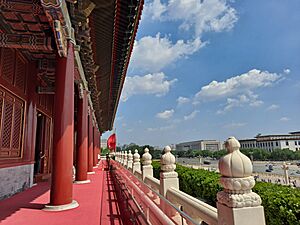
After the Chinese Civil War, the Communist Party came to power. On October 1, 1949, their leader, Mao Zedong, announced the founding of the People's Republic of China from atop Tiananmen Gate. The city's name was changed back to Beijing, and it became the capital once again.
Since then, Beijing has grown into a huge modern city. The old city walls were taken down to build a subway and large ring roads. From 1966 to 1976, China went through a period of major social and political change called the Cultural Revolution, which started in Beijing. In recent decades, the city has modernized rapidly, building skyscrapers and hosting major events like the Olympics.
Geography and Climate
Beijing is located on the northern edge of the North China Plain. Mountains protect the city on its north, northwest, and west sides. These mountains have historically helped defend the city from invaders. The highest point in the area is Mount Dongling, which is 2,303 meters (7,556 feet) tall.
The city itself is flat and spreads out in circles called ring roads. The center of the city is Tian'anmen Square and the Forbidden City.
Beijing has a climate with four distinct seasons. Summers are hot and humid, with most of the year's rain falling from June to August. Winters are cold, dry, and windy. Spring and autumn are mild but can be dry. Sometimes in the spring, dust storms from the Gobi Desert can blow into the city.
What Beijing Looks Like
Architecture
You can see three main styles of buildings in Beijing:
- Traditional Chinese architecture: This includes beautiful old buildings like the Forbidden City and the Temple of Heaven, with their curved roofs and detailed decorations.
- "Sino-Sov" style: These are boxy, simple buildings from the 1950s to the 1970s.
- Modern architecture: In areas like the Beijing CBD, you can see amazing modern skyscrapers, like the CCTV Headquarters building, and unique structures like the National Stadium (the "Bird's Nest").
Beijing is also famous for its traditional neighborhoods made up of hutongs (narrow alleys) and siheyuans (courtyard houses). In a siheyuan, several houses are built around a shared courtyard. Sadly, many hutongs and siheyuans are being torn down to make way for modern buildings.
Environmental Issues
Like many big cities, Beijing has faced environmental challenges, especially air pollution, often called smog. The pollution comes from cars, factories, and burning coal for heat and electricity. The government has been working hard to fix this problem.
To improve air quality, the city has closed old factories, switched from coal to cleaner natural gas, and limited the number of cars on the road. These efforts helped a lot during the 2008 Summer Olympics and have continued since. The air quality in Beijing has gotten much better in recent years.
Government and Districts
As the capital of China, Beijing is the home of the national government. The city itself is run by a mayor and a party secretary. Beijing is a special type of city called a municipality, which means it has the same status as a province.
The city is divided into 16 districts. The central districts, like Dongcheng and Xicheng, are where you'll find most of the historical sites. Other districts are suburban or rural.
| Administrative divisions of Beijing | ||||||||||||||
|---|---|---|---|---|---|---|---|---|---|---|---|---|---|---|

Dongcheng
Xicheng
Chaoyang
Fengtai
Shijingshan
Haidian
Mentougou
Fangshan
Tongzhou
Shunyi
Changping
Daxing
Huairou
Pinggu
Miyun
Yanqing
|
||||||||||||||
| Division code | Division | Area in km2 | Total population 2020 | Urban area population 2020 |
Seat | Postal code | Subdivisions | |||||||
| Subdistricts | Towns | Townships |
Residential communities | Villages | ||||||||||
| 110000 | Beijing | 16406.16 | 21,893,095 | 19,166,433 | Dongcheng / Tongzhou | 100000 | 149 | 143 | 38 | 2538 | 3857 | |||
| 110101 | Dongcheng | 41.82 | 708,829 | Jingshan Subdistrict | 100000 | 17 | 216 | |||||||
| 110102 | Xicheng | 50.33 | 1,106,214 | Jinrong Street Subdistrict | 100000 | 15 | 259 | |||||||
| 110105 | Chaoyang | 454.78 | 3,452,460 | Chaowai Subdistrict | 100000 | 24 | 19 | 358 | 5 | |||||
| 110106 | Fengtai | 305.53 | 2,019,764 | 2,003,652 | Fengtai Subdistrict | 100000 | 16 | 2 | 3 | 254 | 73 | |||
| 110107 | Shijingshan | 84.38 | 567,851 | Lugu Subdistrict | 100000 | 9 | 130 | |||||||
| 110108 | Haidian | 430.77 | 3,133,469 | 3,058,731 | Haidian Subdistrict | 100000 | 22 | 7 | 603 | 84 | ||||
| 110109 | Mentougou | 1447.85 | 392,606 | 358,945 | Dayu Subdistrict | 102300 | 4 | 9 | 124 | 179 | ||||
| 110111 | Fangshan | 1994.73 | 1,312,778 | 1,025,320 | Gongchen Subdistrict | 102400 | 8 | 14 | 6 | 108 | 462 | |||
| 110112 | Tongzhou | 905.79 | 1,840,295 | 1,361,403 | Beiyuan Subdistrict | 101100 | 6 | 10 | 1 | 40 | 480 | |||
| 110113 | Shunyi | 1019.51 | 1,324,044 | 875,261 | Shengli Subdistrict | 101300 | 6 | 19 | 61 | 449 | ||||
| 110114 | Changping | 1342.47 | 2,269,487 | 1,856,115 | Chengbei Subdistrict | 102200 | 8 | 14 | 180 | 303 | ||||
| 110115 | Daxing | 1036.34 | 1,993,591 | 1,622,382 | Xingfeng Subdistrict | 102600 | 5 | 14 | 64 | 547 | ||||
| 110116 | Huairou | 2122.82 | 441,040 | 334,682 | Longshan Subdistrict | 101400 | 2 | 12 | 2 | 27 | 286 | |||
| 110117 | Pinggu | 948.24 | 457,313 | 278,501 | Binhe Subdistrict | 101200 | 2 | 14 | 2 | 23 | 275 | |||
| 110118 | Miyun | 2225.92 | 527,683 | 350,398 | Gulou Subdistrict | 101500 | 2 | 17 | 1 | 57 | 338 | |||
| 110119 | Yanqing | 1994.89 | 345,671 | 205,689 | Rulin Subdistrict | 102100 | 3 | 11 | 4 | 34 | 376 | |||
Economy
Beijing has a very strong and modern economy. It is a post-industrial economy, which means most of its money comes from services instead of factories. Important industries include finance, information technology (IT), scientific research, and tourism.
Many of China's largest companies have their headquarters in Beijing. The city is also home to more headquarters of Fortune Global 500 companies than any other city in the world.
Some important economic zones in Beijing are:
- Zhongguancun: This area is known as "China's Silicon Valley" because it is home to many technology companies.
- Beijing Central Business District (CBD): This is where you'll find most of the city's tallest skyscrapers and the offices of many international companies.
- Beijing Financial Street: This is the center for China's biggest banks and financial companies.
People and Education
As of 2021, Beijing's population was about 21.89 million people. It is the second-largest city in China after Shanghai. Most of the people living in Beijing are Han Chinese, but there are also many ethnic minority groups, including Manchu, Hui, and Mongol people.
Beijing is a world-leading center for education and research. It has more than 90 universities and colleges. Two of the best universities in all of Asia, Peking University and Tsinghua University, are located here. The city is also home to the Chinese Academy of Sciences, one of the top research institutions in the world.
Culture
Language and Opera
The local language is the Beijing dialect, which is the basis for Standard Mandarin Chinese, the official language of China.
One of Beijing's most famous cultural treasures is Peking opera. It's a type of Chinese theater that combines singing, speaking, acting, and acrobatics. The performers wear elaborate costumes and makeup to tell stories from Chinese history and folklore.
Food and Art

Beijing has its own special style of cooking. The most famous dish is Peking duck, which is known for its crispy skin and tender meat. It is often served with thin pancakes, scallions, and a sweet bean sauce.
The city is also known for its beautiful traditional crafts. Cloisonné is a technique of creating colorful designs on metal objects with enamel. Lacquerware involves carving detailed patterns into objects coated with many layers of lacquer.
Places to Visit
Beijing is filled with incredible places to see. Many of them are recognized as UNESCO World Heritage Sites.
Famous Landmarks

- Forbidden City: The former imperial palace for 24 emperors. It is a massive complex of palaces, halls, and gardens right in the center of Beijing.
- Tiananmen Square: A huge public square in front of the Forbidden City. It is surrounded by important buildings like the Great Hall of the People and the National Museum of China.
- Temple of Heaven: A beautiful temple complex where emperors of the Ming and Qing dynasties would pray to heaven for a good harvest.
- Summer Palace: A vast and beautiful park with lakes, gardens, and palaces. It was used as a summer retreat for the emperors.
- Great Wall of China: Several sections of the Great Wall, such as Badaling and Mutianyu, are located just outside Beijing and are popular for day trips.
Parks and Museums
Beijing has many beautiful parks, like Beihai Park, which is a classic example of a Chinese imperial garden. The Beijing Zoo is famous for its collection of animals, especially the giant panda.
The city also has over 100 museums. The National Museum of China is one of the largest in the world, and the Palace Museum (inside the Forbidden City) holds a huge collection of imperial treasures.
Sports
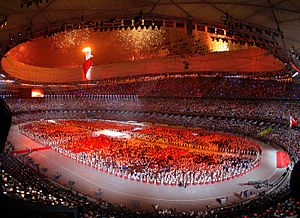
Beijing is a major city for sports. It is the only city in the world to have hosted both the Summer and Winter Olympic Games.
- 2008 Summer Olympics: For these games, Beijing built amazing venues like the Beijing National Stadium (the "Bird's Nest") and the National Aquatics Center (the "Water Cube").
- 2022 Winter Olympics: The city reused many of the 2008 venues and also built new ones for winter sports.
Beijing is home to many professional sports teams, including the popular soccer team Beijing Guoan and the basketball team, the Beijing Ducks.
Transportation
Getting around Beijing is easy thanks to its modern transportation system. In late 2010, Beijing's government introduced strict measures to reduce traffic congestion. These rules limited new car registrations to 20,000 per month and banned non-local cars from the city center during rush hour. The government can also impose further restrictions during major events or periods of heavy pollution.
To legally drive in Beijing, residents must win a license plate lottery. However, the city encourages the adoption of electric vehicles by giving applicants for fully electric cars a much higher chance of winning. Owners of these vehicles are also exempt from weekday driving bans.
Subway and Buses
The Beijing Subway is one of the longest and busiest in the world. It has over 25 lines that connect almost every part of the city. It's a fast, clean, and affordable way to travel. The city also has a large network of public buses.
Airports and Trains
Beijing has two huge international airports:
- Beijing Capital International Airport (PEK)
- Beijing Daxing International Airport (PKX), which opened in 2019 and has one of the largest terminal buildings in the world.
Beijing is also a major hub for China's amazing high-speed rail network. You can take a high-speed train from Beijing to almost any other major city in China, including Shanghai and Guangzhou.
Bicycles
Beijing was once known as the "Bicycle Kingdom." While cars are much more common now, many people still ride bikes. The city is mostly flat, and there are bike lanes on many streets. In recent years, bike-sharing systems have become very popular, making it easy for anyone to rent a bike using a smartphone app.
See also
 In Spanish: Pekín para niños
In Spanish: Pekín para niños


